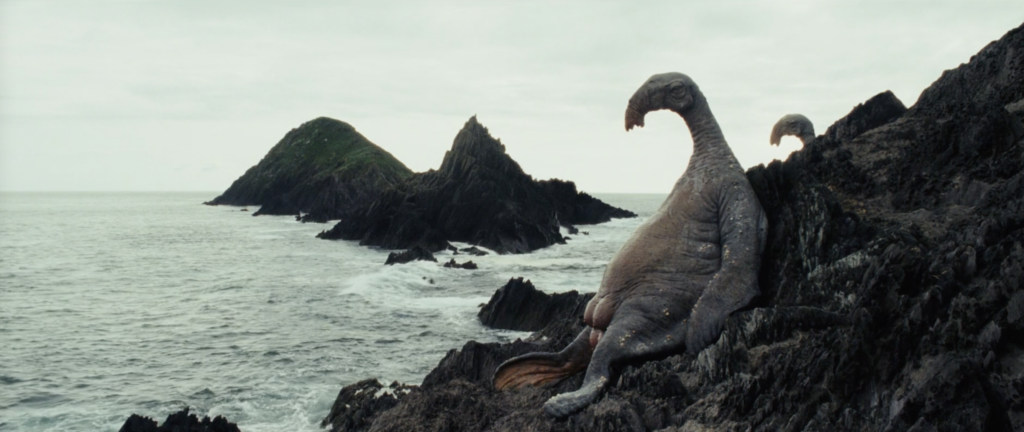The Last Jedi - An Dún Mór
An Dún Mór
|
Dunmore Head
Address
Com Dhíneol Thuaidh, Dún Chaoin, Corca Dhuibhne
52.109136
, -10.477651

An Dún Mór, Ireland’s most westerly point, was the site of the infamous Sea Cow scene in space opera The Last Jedi. Large puppet alien creatures were built in England, and transported by helicopter to the bristling rocks on the end of the headland. The puppeteers were sealed into the creatures for the day, in a gruelling endurance test, mostly fuelled by Coca Cola. In one amusing incident, some tourists happened to capture images of the creature while passing by on a boat. Alarmed at the prospect of these images being leaked to the public, security bribed them to delete the pictures with the offer of several free meals.
Many locals were involved in this production, between transport, security, safety supervision, and construction. In one famous event, the alien creature Chewbacca made an appearance at the local primary school.
The filming of certain key scenes from the second installment in the last trilogy of Star Wars films to date, The Last Jedi, has resulted in a new burst of cinephile tourism to the west of Dingle, reminiscent of how Ryan’s Daughter brought Dingle into Hollywood’s sphere of influence.
For The Last Jedi, the beehive huts of Skellig Michael (previously the shooting location for Luke Skywalker’s remote home planet of Ahch-To) were recreated on the clifftop of Ceann Sibéal near Ballyferriter as a means of ensuring the delicate Skellig ecosystem and UNESCO heritage site would not be disturbed by further filming. The cliffs adjacent to Comuineol beach, directly under the most westerly point on mainland Ireland, Dún Mór, were also used for a scene in which Luke is seen milking a monstrous sea creature for its blue milk (evidently his favorite snack, as first seen in the original Star Wars: A New Hope from 1977).
For these latter shots, practical effects – including a huge puppet, transported via helicopter – were used, over the almost exclusive CGI (arguably over)used in previous installments like The Phantom Menace from 1999. This re-orientation towards practical effects and on-location shooting, integrated with CGI, help The Last Jedi alongside its sister films The Force Awakens and The Rise of Skywalker, achieve an immersively realistic effect towards the prolonged suspension of audiences’ disbelief.
Those who have seen the coastline of West Kerry will, of course, know immediately that the background seascapes of these shots have been CGI’d in such a way as to remove their geographical specificity (particularly through the editing-in of multiple rocks and islands) so that these scenes reflect more the sublime “feel” of a West Kerry landscape than they visually depict what really exists. Nor should they: we are in Ahch-To for these scenes, not Ireland, or any filmmaker’s, like David Lean’s or Ron Howard’s, vision/version of Ireland. This is fantasy owning fantasy.
Sacred Heart Student Eric Patrick Cameron made a documentary about the filming in West Kerry, which features interviews with locals, SHU in Dingle professors, and the director of the film Rian Johnson.
Videos
Links
- » https://en.wikipedia.org/wiki/Star_Wars:_The_Last_Jedi
- » https://www.imdb.com/title/tt2527336/
- »https://en.wikipedia.org/wiki/Dunmore_Head
- » https://www.cinemablend.com/news/2470282/the-time-star-wars-security-had-to-bribe-tourists-to-delete-spoiler-photos
- » https://www.esquire.com/food-drink/food/a14608719/milking-scene-star-wars-the-last-jedi/

